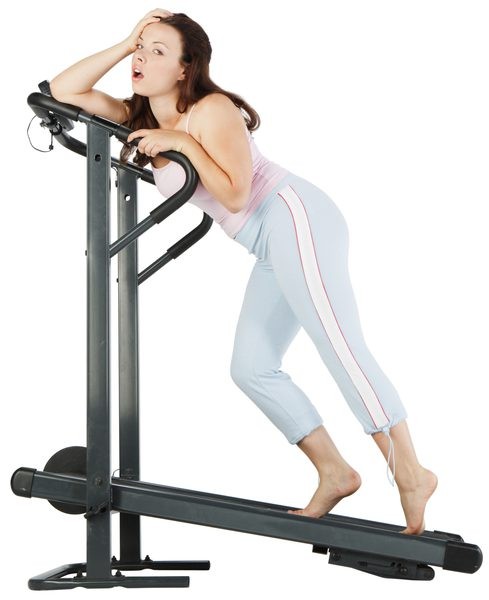You hit the gym hard, doing plenty of squats, lunges, machines and classes, but your backside still isn’t as defined or perky as you’d like. You’ve been tearing out magazine clippings to bring with you to the gym. You’ve been doing more squats because that’s what all of the hashtags on Instagram say to do. You’ve noticed a change in your strength level, but there have been no real changes in the shape of your butt. What gives? Some women have an easier time building glutes than others, based on genetics, but there are a number
of other factors that have nothing to do with your genes. Here are some possible reasons why you haven’t seen any booty changes.
You Are Sitting Too Much

The glute muscles are designed to be the largest and most powerful muscles in the body. The glutes are the center of your body and are involved in nearly all movement patterns. They contract to move your hips in every direction: up, down, forward, back, and side to side. They play an integral role in your overall health, wellness, function and physical strength. The gluteal muscles are a significant contributor to proper posture, physical aesthetics, the rehabilitation of low back, hip, and knee, as well as optimal athletic performance. The problem is, although these muscles are designed to be strong, the glutes will be pretty lazy if you allow them to be. The more sedentary we become, the less we use our glutes. This causes other muscles to take over and do tasks that they are not meant to do, which leads to injuries and issues, such as low back pain. Sitting in a chair for hours causes “gluteal amnesia.” This is a growing problem due to the prevalence of desk and office jobs. Many people who sit too much have tight hip flexors, which means the gluteal muscles are not easily activated. One sign of lazy glutes is hamstring tightness when doing lower body exercises. When your glutes don’t activate properly, your hamstrings are forced to pick up the slack. If you have a desk job, I recommend you stand up and walk around every 30 minutes. Every hour, do bodyweight exercises, like glute bridges or standing leg kickbacks and leg lifts, focusing on squeezing and contracting the glutes. Stretching throughout the day will also help to lengthen tight hip flexors.
You Haven’t Mastered the Mind-Muscle Connection

When it comes to enhancing the shape of the glutes, it all starts with the mind-muscle connection. Knowing how to activate a muscle during exercise is extremely important and is especially true for the gluteus maximus. The gluteus maximus does not activate highly during activities of daily life, which helps explain why it tends to shut down and atrophy. Special techniques are needed to wake up the glutes and get them firing optimally during movement. This means that while you are performing a glute exercise, you must focus on contracting the glutes. Learning how to effectively activate the glutes during exercise is critical to performance and progress. There are several tips that can help with developing the mind-muscle connection. Contracting the glutes in an isometric fashion should be done throughout the day. Try squeezing the glutes hard for 10 seconds at a time. Warm up exercises are also helpful before a lower body workout. Bodyweight glute bridges, side-lying clam shells, donkey kicks and lateral band walks are effective ways to turn on the glutes before your workout. Remember, the goal is to increase the weight since the glutes need direct, heavy or explosive hip movement. However, if you go too heavy and stop feeling the glutes working, you must lighten the load. Good, technical form should always be top priority.
You Are Doing Too Much Cardio

(Tyson Gay- American track & field sprinter)
Steady-state cardio, such as jogging, is not going to give you the lean, ripped physique you desire. Excessive cardio actually works against your goals of having a nice butt. You can train hard or long but not both. You must train smart in order to see results. If you are getting to the gym and leaving two and a half hours later, you’re spending a lot of time for an increasingly diminishing return. The more cardio you do, the more efficient your body becomes at burning calories. Due to increased efficiency, this means you will burn LESS calories than you used to. This also leaves you with less energy to give each training session the intensity it deserves. If you enjoy jogging or other forms of long distance aerobic exercise, then you must work hard to preserve muscle and avoid the inevitable break down of muscle for energy. This is a common problem I see with many females. Most women think long, drawn out bouts of cardio will help them burn fat and get in shape. When in all actuality, it is muscle that gives the body its tight toned shape. I recommend sprinting a couple of times a week. These intervals should be short bursts of all out work, followed by periods of recovery. Sprinting is great for the glutes. And strong glutes are great for sprinting.
The Bottom Line (no pun intended)
If having stronger, more defined glutes is your goal, then a couple of sets of squats and lunges one day a week will not be enough to maximize glute development. I suggest incorporating direct glute work and a variety of glute-focused exercises into your workouts 2-3 days a week. Take advantage of the time between workouts to do isometric butt squeezes. And if you want a nice butt, for goodness sake get off your butt! It’s important to get up from your chair often, move around and stretch. Don’t get discouraged if you can’t feel the glutes firing in the beginning. Persistence and frequent activation is the key. Over time the brain learns how to better activate the glutes. Stay consistent with your training and nutrition, and you should see results in 4-6 weeks.

Resistance Band Kit: www.BusyBeeBody.com